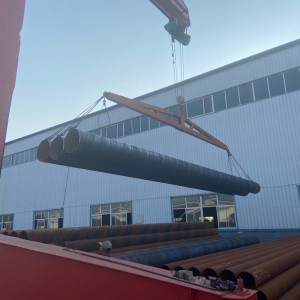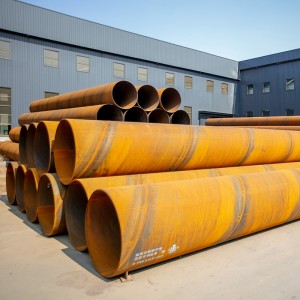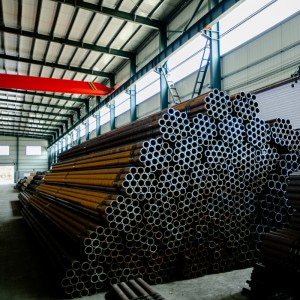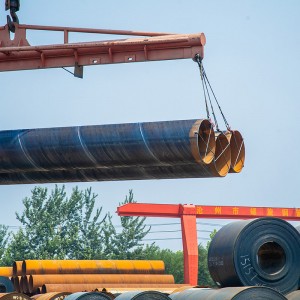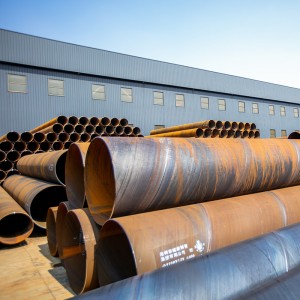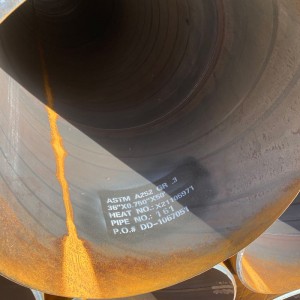Spiral Seam Pipes For Main Water Pipes
In infrastructure construction, the materials used play a vital role in the longevity and functionality of the project. One material that is indispensable to the infrastructure industry is spiral welded pipe. These pipes are commonly used in a variety of applications such as water mains and gas pipes, and their specifications, including welded and spiral seam pipes, are critical to ensuring their performance. In this blog, we will take an in-depth look at the spiral welded pipe specification and their importance in the construction industry.
Spiral seam pipes are constructed using a method called the spiral welding process. The process involves using hot-rolled coils of steel to be formed into a cylindrical shape and then welded along a spiral seam. The result is a pipe with high strength and durability, making it suitable for a wide range of applications. These pipes use welded tube technology during construction, ensuring they are resistant to a variety of environmental factors and pressures, making them ideal for underground and underwater use.
|
Main Physical and Chemical Properties of Steel Pipes (GB/T3091-2008, GB/T9711-2011 and API Spec 5L) |
||||||||||||||
|
Standard |
Steel Grade |
Chemical Constituents (%) |
Tensile Property |
Charpy(V notch)Impact Test |
||||||||||
| c | Mn | p | s | Si |
Other |
Yield Strength(Mpa) |
Tensile Strength(Mpa) |
(L0=5.65 √ S0 )min Stretch Rate (%) |
||||||
| max | max | max | max | max | min | max | min | max | D ≤ 168.33mm | D > 168.3mm | ||||
|
GB/T3091 -2008 |
Q215A | ≤ 0.15 | 0.25 < 1.20 | 0.045 | 0.050 | 0.35 |
Adding Nb\V\Ti in accordance with GB/T1591-94 |
215 | 335 | 15 | > 31 | |||
| Q215B | ≤ 0.15 | 0.25-0.55 | 0.045 | 0.045 | 0.035 | 215 | 335 | 15 | > 31 | |||||
| Q235A | ≤ 0.22 | 0.30 < 0.65 | 0.045 | 0.050 | 0.035 | 235 | 375 | 15 | >26 | |||||
| Q235B | ≤ 0.20 | 0.30 ≤ 1.80 | 0.045 | 0.045 | 0.035 | 235 | 375 | 15 | >26 | |||||
| Q295A | 0.16 | 0.80-1.50 | 0.045 | 0.045 | 0.55 | 295 | 390 | 13 | >23 | |||||
| Q295B | 0.16 | 0.80-1.50 | 0.045 | 0.040 | 0.55 | 295 | 390 | 13 | >23 | |||||
| Q345A | 0.20 | 1.00-1.60 | 0.045 | 0.045 | 0.55 | 345 | 510 | 13 | >21 | |||||
| Q345B | 0.20 | 1.00-1.60 | 0.045 | 0.040 | 0.55 | 345 | 510 | 13 | >21 | |||||
|
GB/T9711-2011(PSL1) |
L175 | 0.21 | 0.60 | 0.030 | 0.030 |
Optional adding one of Nb\V\Ti elements or any combination of them |
175 | 310 |
27 |
One or two of the toughness index of impact energy and shearing area may be chosen. For L555, see the standard. |
||||
| L210 | 0.22 | 0.90 | 0.030 | 0.030 | 210 | 335 |
25 |
|||||||
| L245 | 0.26 | 1.20 | 0.030 | 0.030 | 245 | 415 |
21 |
|||||||
| L290 | 0.26 | 1.30 | 0.030 | 0.030 | 290 | 415 |
21 |
|||||||
| L320 | 0.26 | 1.40 | 0.030 | 0.030 | 320 | 435 |
20 |
|||||||
| L360 | 0.26 | 1.40 | 0.030 | 0.030 | 360 | 460 |
19 |
|||||||
| L390 | 0.26 | 1.40 | 0.030 | 0.030 | 390 | 390 |
18 |
|||||||
| L415 | 0.26 | 1.40 | 0.030 | 0.030 | 415 | 520 |
17 |
|||||||
| L450 | 0.26 | 1.45 | 0.030 | 0.030 | 450 | 535 |
17 |
|||||||
| L485 | 0.26 | 1.65 | 0.030 | 0.030 | 485 | 570 |
16 |
|||||||
|
API 5L (PSL 1) |
A25 | 0.21 | 0.60 | 0.030 | 0.030 |
For grade B steel,Nb+V ≤ 0.03%;for steel ≥ grade B,optional adding Nb or V or their combination, and Nb+V+Ti ≤ 0.15% |
172 | 310 |
(L0=50.8mm)to be calculated according to the following formula:e=1944·A0 .2/U0 .0 A:Area of sample in mm2 U: Minimal specified tensile strength in Mpa |
None or any or both of the impact energy and the shearing area is required as toughness criterion. |
||||
| A | 0.22 | 0.90 | 0.030 | 0.030 | 207 | 331 | ||||||||
| B | 0.26 | 1.20 | 0.030 | 0.030 | 241 | 414 | ||||||||
| X42 | 0.26 | 1.30 | 0.030 | 0.030 | 290 | 414 | ||||||||
| X46 | 0.26 | 1.40 | 0.030 | 0.030 | 317 | 434 | ||||||||
| X52 | 0.26 | 1.40 | 0.030 | 0.030 | 359 | 455 | ||||||||
| X56 | 0.26 | 1.40 | 0.030 | 0.030 | 386 | 490 | ||||||||
| X60 | 0.26 | 1.40 | 0.030 | 0.030 | 414 | 517 | ||||||||
| X65 | 0.26 | 1.45 | 0.030 | 0.030 | 448 | 531 | ||||||||
| X70 | 0.26 | 1.65 | 0.030 | 0.030 | 483 | 565 | ||||||||
When considering the specifications for spiral seam pipe, it is important to focus on key factors such as diameter, wall thickness and material grade. The diameter of a pipe determines its ability to transport a fluid or gas, while the wall thickness plays a vital role in its structural integrity and pressure resistance. In addition, material grade represents the quality and composition of the steel used and is an important consideration in ensuring the longevity and performance of the pipe in a given application.
In the construction of main water pipes, spiral seam pipes have many advantages. Their high tensile strength and corrosion resistance make them ideal for transporting water over long distances, while their flexibility allows for easy installation around obstacles and in challenging terrain. In addition, the use of spiral seam pipes in natural gas pipelines ensures the safe and efficient transportation of natural gas, providing an important resource for the residential, commercial and industrial sectors.
On the infrastructure side, spiral seam pipe specifications are governed by industry standards and regulations to ensure their quality and performance. For example, the American Petroleum Institute (API) has developed standards for the manufacture and use of spiral-seam pipe that outline requirements for size, strength, and testing procedures. In addition, the American Society for Testing and Materials (ASTM) provides material composition and mechanical property specifications for spiral seam pipes to further ensure their reliability and compliance with industry standards.
In summary, the spiral welded pipe specification are critical to their role in infrastructure construction. Whether used for water mains or gas lines, these pipes offer unparalleled strength, durability and versatility, making them indispensable in the modern world. By adhering to industry standards and regulations, the use of spiral seam pipes ensures the safety and efficiency of critical infrastructure systems, paving the way for sustainable development and social progress.




